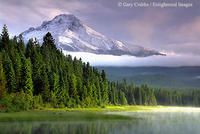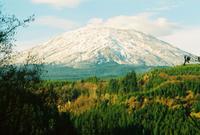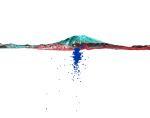
Gorges, Volcanos and Starbucks
The deposition in Oregon went very well, as it turned out. I drove west from the City, towards the Pacific. I drove through Douglas fir tree farms and fields of orchards, and along a ridge of hills that forms part of the Coast Range. It was a cold, sunny morning and under the orchard trees the ground was white from frost. There was barely any traffic. I past a million fresh produce and organic dairy stands The deposition was in a small town called Hillsboro, and the law firm I was in was right across the street from the tiny Washington County courthouse. The law firm looked like a one story concrete slab, but inside it was an architectural marvel -- several subterranean floors, skylights, profusions of orchids, little knooks of rooms filled with casebooks. This was clearly the center of the action in Washington County legal circles.
The deponent was a former professional trumpet player from Los Angeles who had run away to Oregon when his wife left him for a richer guy. The deponent had build a "hand-made house" in the Oregon woods, where he works as a technical write for Intel -- a job he can dow without leaving the side of his wood burning stove. He wore jeans and a very thin, light blue T-shirt that said OREGON! on it. He spilled all sorts of dirt on our litigation adversary (who was sleeping with who, who stole who's girlfriend, etc.) -- it was a surprisingly successful session.
We were done by noon and I had ten and a half hours to kill before my flight -- which, incidentally, departed from Seattle, not Portland. So I stocked up on pistachio nuts and peanuts, and headed east. First stop was the Columbia River Gorge. I had been listening to NPR in the car and knew two important things were happening in Oregon -- an airplane had hit an elk on a runway in Astoria, and there was a wicked, terrible wind and a fog warning in what they called "the Western Gorge." My Alamo rental car map suggested there were a number of Lewis & Clark historic sites to visit in the Western Gorge, so I went. It was absolutely stunning. Practically within sight of the Portland airport is this fabulous gorge -- the Columbia River is wide and rough -- on Tuesday it was covered in white caps. The earth goes up vertically on each side of the River, and I don't know what the rock is but it is very dark gray and covered in fir trees and primeval looking in the extreme. The entrance to the gorge was sunny -- as you went west you could see the fog stopping up the gorge and making the sky look yellow and gray and ery violent. Believe it or not, an Interstate highway runs down the south side of the gorge, wedged between the granite (I assume?) cliffs and yellow river grass paddies that line the river. The highway was in the shade -- the yellow river grass was very bright in the sun, the river was bright blue. It was like something out of a Western landscape painting. I took a right turn and drove straight up to the top of the hills (this was no longer the Coast Range -- these were the Cascade Mountains) and I found a flat windy place at the top where I could see Mt. Hood and Mt. St. Helen's and Portland. I was parked in the driveway of an apple orchard, and two nice dogs (one yellow and one black laborador) came out and kept me company. They were accustomed to the wind. We got along well -- I took a picture of them next to my rental car with my disposal camera. There were no people anywhere.
Then I headed north up I-5 into Washington State on the way to Seattle. Almost the whole way, Mt St. Helen's was off to the right. Because of the mountains, it got dark by about 3:30 p.m. but the mountain was standing up straight in the sun and was covered in snow and glowed. About 1.5 hours after leaving the Columbia River Gorge, I passed a sign that said, "National Volcanic Monument -- 5 Miles from Highway." I was in a town called Chehalis. I took the turn, and drove through a dense Douglas fir forest for 5 miles, until I found a wooden, mountain lodge. There was no wind and down at the bottom of the tall trees it was very very quiet. Douglas firs are very big -- they live for 1,000 years and can be several hundred feet tall. They are the big tree featured on Oregon license plates. They have excellent personalities -- much better than spruce trees or hemlock trees.

As I walked down the hill to the lodge, I realized that you could see Mt. St. Helen's through a crack in the gloomy fir trees. It was still sitting in the sun -- it was glowing white -- it was perfecty silent out and there was a bright blue lake between me and the mountain. There were no people anywhere, and you couldn't even hear the sound of the highway. It was a bizarre feeling -- almost a religious experience. The mountain just sat out there in the sun. Totally silent.
Inside the lodge there was a very cool exhibit about the eruption in 1980. Still no people. While going through the exhibit I remembered when I first learned about Mt. St. Helens -- we were living in Zambia and we got a National Geographic that showed pictures of the eruption and the ensuing devastation. It was very weird to see it all of sudden, unexpectedly, so far away from Zambia and to find it sitting all by itself with no people around.

I learned from the exhibit that the eruption was preceded by almost 300 earthquakes in the 4 days leading up to the eruption, and that if they hadn't evacuated the mountains the week before the eruption, as many as 2000 people might have died. Apparently dust from the eruption ruined a parade in Spokane -- on the other side of the state -- and the eruption was heard as far away as Boise, Idaho. The lodge had a viewing platform where you could sit and look at the volcano for as long as you wanted. I decided Mt. St. Helen's was my favorite volcano.
Next stop was Seattle. By this time I was getting tired so I did only three things in Seattle before heading to the airport:
1. I drove the front bumper of my red Chevy Cavalier as close as I could get it to the Space Needle.
 2. I went to the Pike Place Market and had a grande vanilla latte at the Original Starbucks.
2. I went to the Pike Place Market and had a grande vanilla latte at the Original Starbucks.3. I drove around the new Seattle Marinrer's baseball stadium, which is built on top of the BNSF mainline which carries loaded freight trains under the spectators and off to the Port of Seattle, where they get put on boats and sent off to Asia. Near the stadium is the Starbucks Corporate headquarters -- very comforting sight. All lit up with the giant green woman emblem on the top of the building.
Then it was to the SeaTac airport to wait for the redeye back to Dulles. Being the West Coast, the place was practically shutdown when I got there at 8 p.m. All the eating establishments were shut (even Starbucks) and the United monitors showed ony about 10 flights left to depart that night. The Dulles redeye was the absolute dead last flight to leave the terminal. I checked in and got through security in about 10 minutes, and spent the next 2.5 hours doing absolutely nothing. I wonder what people on the West Coast do at night. They are either all gourmet cooks who eat at home, or they are an extremely well-rested people.
Redeye was beautiful. It's entertaining to look down at the lights all the way across the continent - the fog and condesation blurs them so the towns glow up out of the clouds like a Disney movie. And you can see the stars because you are above the clouds. Landed at Dulles just before sunrise. Dulles was abuzz - all the other redeyes get in around the same time, and the differene between the lifeless West Coast airports and the perpetually open East Coast airports is remarkable. I remember thinking the same thing coming in on the SF redeyes. Starbucks was already open.


0 Comments:
Post a Comment
<< Home